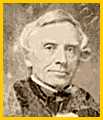MORSE CODE
 Samuel Finley Breese Morse (1791-1872) was an American inventor and painter. After a successful career painting in oils (first painting historical scenes and then portraits), Morse built the first American telegraph around 1835 (the telegraph was also being developed independently in Europe). Samuel Finley Breese Morse (1791-1872) was an American inventor and painter. After a successful career painting in oils (first painting historical scenes and then portraits), Morse built the first American telegraph around 1835 (the telegraph was also being developed independently in Europe).
A telegraph sends electrical signals over a long distance, through wires. In 1830, Joseph Henry (1797-1878) made the first long-distance telegraphic device - he sent an electric current for over a mile on wire that activated an electromagnet, causing a bell to ring.
Morse patented a working telegraph machine in 1837, with help from his business partners Leonard Gale and Alfred Vail. Morse used a dots-and-spaces code for the letters of the alphabet and the numbers (Morse Code was later improved to use dots, dashes and spaces: for example E is dot, T is dash, A is dot-dash, N is dash-dot, O is dash-dash-dash, I is dot-dot, S is dot-dot-dot, etc.). By 1838, Morse could send 10 words per minute. Congress provided funds for building a telegraph line between Washington D.C. and Baltimore, Maryland, in 1843. Morse sent the first telegraphic message (from Washington D.C. to Baltimore) on May 24, 1844; the message was: "What hath God wrought?" The telegraph revolutionized long-distance communications that previously took days because of the need to transport hand-written information. |
 Cyrus Hall McCormick (February 15, 1809 - May 13, 1884) was an American inventor (of Irish descent) who developed the mechanical reaper. His new machine combined many of the steps involved in harvesting crops, greatly increased crop yields, decreased the number of field hands needed for the harvest, lowered costs, and revolutionized farming. Before this development, each step was done by hand.
Cyrus Hall McCormick (February 15, 1809 - May 13, 1884) was an American inventor (of Irish descent) who developed the mechanical reaper. His new machine combined many of the steps involved in harvesting crops, greatly increased crop yields, decreased the number of field hands needed for the harvest, lowered costs, and revolutionized farming. Before this development, each step was done by hand.
 Samuel Finley Breese Morse (1791-1872) was an American inventor and painter. After a successful career painting in oils (first painting historical scenes and then portraits), Morse built the first American telegraph around 1835 (the telegraph was also being developed independently in Europe).
Samuel Finley Breese Morse (1791-1872) was an American inventor and painter. After a successful career painting in oils (first painting historical scenes and then portraits), Morse built the first American telegraph around 1835 (the telegraph was also being developed independently in Europe).
 The safety pin was invented by Walter Hunt in 1849. Hunt 1795-1859) patented the safety pin on April 10, 1849 (patent No. 6,281). Hunt's pin was made by twisting a length of wire. Hunt invented the safety pin in order to pay a debt of $15; he eventually sold the rights to his patent for $400. It was the first pin to have a clasp and spring action and Hunt claimed that it was designed to keep fingers safe from injury. Before the Hunt's version, pins were straight, sharp pieces of metal that would often poke the wearer of the pinned garment.
The safety pin was invented by Walter Hunt in 1849. Hunt 1795-1859) patented the safety pin on April 10, 1849 (patent No. 6,281). Hunt's pin was made by twisting a length of wire. Hunt invented the safety pin in order to pay a debt of $15; he eventually sold the rights to his patent for $400. It was the first pin to have a clasp and spring action and Hunt claimed that it was designed to keep fingers safe from injury. Before the Hunt's version, pins were straight, sharp pieces of metal that would often poke the wearer of the pinned garment.